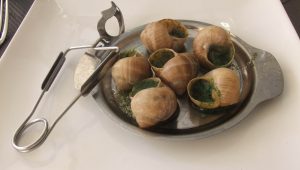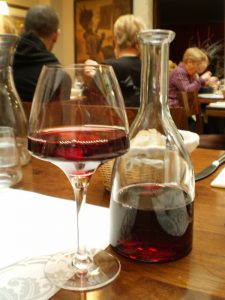There are three options available to the hungry traveller in France:
Be very French. Have a restaurant meal for lunch, and just grab something light for tea from the shops which are generally open till 8pm. It’s not only a healthier alternative to avoid large meals at night, but a lot cheaper to eat a restaurant lunch than the same meal at dinner time.
Be even more French, and dine in for both lunch and dinner – a sumptuous experience which simultaneously increases the waistline and reduces the wallet.
Be incredibly French. Buy a baguette in the morning, have it sticking out your bag till lunchtime, then eat it unfilled while walking around. Afterwards pop into a café for a lunchtime espresso (never a cappuccino after midday). It’s cheap and, unlike breadsticks, baguettes actually taste really good on their own.
It is an advantage when eating in a restaurant is knowing what to order from the Daily Specials Menu (menu touristique or menu du jour) which offer the cheapest choices. A French phrase app or book with a good food section is critical, because after learning the essential French words of ‘oui’, ‘non’ & ‘deux croissants s’il vous plait’ (yes, no & 2 croissants please), the most useful words are the foods you don’t like, so you know the dishes to avoid on a menu. I will never forget ris (offal) following an unexpected meal which I thought would contain riz (rice). But on the upside, ordering a ‘grand jatte de chocolat mousse’ when I didn’t know what a ‘jatte’ was resulted in a massive 20cm/8” high glass bowl being brought to my table, full to the brim with chocolate mousse – much to the envy of every other diner.
Not that knowing the name of a dish always helps. Ordering an entrée / starter of  escargots, I expected half a dozen de-shelled snails so was surprised by a large bowl with 18 intact snails hiding in a rich sauce, along with a snail torturing utensil that I guessed was designed to extract the garden dwellers from their portable home, but instead liberated them by launching them across the table.
escargots, I expected half a dozen de-shelled snails so was surprised by a large bowl with 18 intact snails hiding in a rich sauce, along with a snail torturing utensil that I guessed was designed to extract the garden dwellers from their portable home, but instead liberated them by launching them across the table.
The choice of wine in a restaurant or café is simple – order the house wine (pichet or vin de maison) every time. It’s a good wine, much cheaper than bottles and beats trying to pretend you understand French labels.
Despite stories of Gallic arrogance, the only bad service experience we had was where the staff steadfastly avoided our eye contact for 45 minutes. I eventually called out “Nous sommes prêt” to a waitress rushing past, which meant either “We’re ready” or “We are priests”, but still no service. We left and bought a lovely crepe from the market outside at a fraction of the price. I since heard that restaurateur treats French people exactly the same, so I felt like a local.
A common observation that strikes a new traveller is, outside major cities, all the fresh food places close for lunch. To someone brought up on sandwiches for lunch this can be unexpected, especially after an exhausting morning of walking city streets, climbing hilltop villages or shuffling through a museum (the most tiring of them all).
Markets are an excellent food alternative and a great experience to wander through. If you are staying somewhere you can cook, get to the markets. There will be one in a nearby town every day of the week, with a range of local fresh food, wines, a vast selection of cheeses plus unusual market fare such as grandfather clocks and mattresses. Even without any French language, it’s easy, and often amusing, to make any  purchase by pointing, miming quantities and reading the cost from the cash register. It was great to experiment cooking with five types of mushrooms and three kinds of squash. I just wish I could remember the name of the squash that tasted really horrible so I can add it to the ‘ris’ list.
purchase by pointing, miming quantities and reading the cost from the cash register. It was great to experiment cooking with five types of mushrooms and three kinds of squash. I just wish I could remember the name of the squash that tasted really horrible so I can add it to the ‘ris’ list.




Leave a Reply